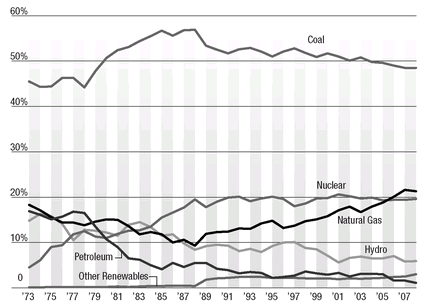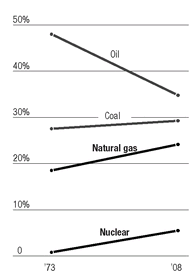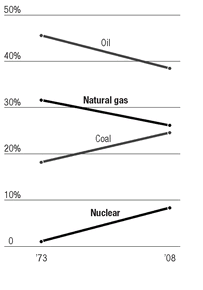Power Hungry (37 page)
Authors: Robert Bryce
The mistaken belief that the United States was running short of natural gas was politically advantageous for the coal producers, who were eager to limit competition from the oil and gas business. And those coal producers had powerful friends in Congress, including, but not limited to, Senator Robert Byrd, the powerful Democrat from West Virginia.
In 1978, Byrd and his allies convinced Congress to pass two bills that would haunt the gas industry for years: the Powerplant and Industrial Fuel Use Act and the Natural Gas Policy Act. The most important provision of the Fuel Use Act was that it prohibited the use of gas for
electricity generation. Meanwhile, the Natural Gas Policy Act created a briar patch of categories for gas pricing based on whether it was sold in interstate or intrastate commerce, what type of wells were involved, and even how deep the wells were.
20
In the wake of the legislation, gas consumption plummeted. By 1986, natural gas consumption had fallen to about 44 billion cubic feet per dayâa level not seen in the United States since 1965.
21
electricity generation. Meanwhile, the Natural Gas Policy Act created a briar patch of categories for gas pricing based on whether it was sold in interstate or intrastate commerce, what type of wells were involved, and even how deep the wells were.
20
In the wake of the legislation, gas consumption plummeted. By 1986, natural gas consumption had fallen to about 44 billion cubic feet per dayâa level not seen in the United States since 1965.
21
In 1987, Congress finally reversed course and repealed the Power-plant and Industrial Fuel Use Act. Although the law was in effect for less than a decade, it did plenty of damage. The ban on the use of natural gas for power generation led many electric utilitiesâwhich were seeing booming demand for electricityâto build more coal plants.
22
In 1978, natural gas was generating 13.8 percent of U.S. electricity. By 1988âa decade after the Powerplant and Industrial Fuel Use Act was passedânatural gas's share of the U.S. electricity business had fallen to a modern low of just 9.3 percent.
22
In 1978, natural gas was generating 13.8 percent of U.S. electricity. By 1988âa decade after the Powerplant and Industrial Fuel Use Act was passedânatural gas's share of the U.S. electricity business had fallen to a modern low of just 9.3 percent.
The winner of all this federal intervention was coal. Between 1973 and 2008, coal's share of the primary energy market jumped from 18 percent to 25 percent.
23
Much of that coal was used for electricity generation. Between 1978âthe year that Congress passed the Powerplant and Industrial Fuel Use Actâand 1988, coal's share of the U.S. electricity generation market soared, going from 44.2 percent to 56.9 percent, the highest level of the modern era.
24
23
Much of that coal was used for electricity generation. Between 1978âthe year that Congress passed the Powerplant and Industrial Fuel Use Actâand 1988, coal's share of the U.S. electricity generation market soared, going from 44.2 percent to 56.9 percent, the highest level of the modern era.
24
The irony here is almost too great. Today, Congress is working mightily to impose a cap-and-trade system or some similar plan aimed at reducing carbon dioxide emissions, and in particular to reduce coal consumption. Had the natural gas sector that was booming back in the 1950s been allowed to continue without excessive federal regulation, U.S. carbon emissions would undoubtedly be lower today, because more gas would be employed for electricity generation and other uses. That would have meant less coal consumption, and therefore lower carbon emissions and less coal-related pollution of mercury, soot, and sulfur dioxide.
In other words, Congress is now trying to find a cure for some of the very same maladies it helped to create. That can be seen by comparing the history of the global gas market with that of the U.S. gas sector. Between 1973 and 2008, natural gas's share of the global primary energy market
rose from 18 percent to 24 percent. Meanwhileâthanks to Congress's illadvised intervention in the domestic energy marketânatural gas's share of the U.S. primary energy market fell from 32 percent to 26 percent.
25
rose from 18 percent to 24 percent. Meanwhileâthanks to Congress's illadvised intervention in the domestic energy marketânatural gas's share of the U.S. primary energy market fell from 32 percent to 26 percent.
25
FIGURE 32
U.S. Electricity Generation, by Fuel Shares, 1973 to 2008
U.S. Electricity Generation, by Fuel Shares, 1973 to 2008

Source
: Nuclear Energy Institute, “Resources and Stats: Generation Statistics,”
http://www.nei.org/resourcesandstats/graphicsandcharts/generationstatistics/
.
: Nuclear Energy Institute, “Resources and Stats: Generation Statistics,”
http://www.nei.org/resourcesandstats/graphicsandcharts/generationstatistics/
.
In his 1996 book
Oil, Gas & Government
, an exhaustive history of the regulation of the U.S. oil and gas business, author Robert L. Bradley Jr. wrote that the result of federal regulatory forays into the natural gas market was that the electricity industry had to substitute “the most pollutive fossil fuel (coal) for the cleanest fossil fuel (gas).”
26
Oil, Gas & Government
, an exhaustive history of the regulation of the U.S. oil and gas business, author Robert L. Bradley Jr. wrote that the result of federal regulatory forays into the natural gas market was that the electricity industry had to substitute “the most pollutive fossil fuel (coal) for the cleanest fossil fuel (gas).”
26
The thicket of regulations on the gas sector eventually became so onerous that Congress finally had no choice but to repeal most of them. And much of that deregulation occurred during the administrations of Ronald Reagan and George H.W. Bush. But even as the natural gas business was being gradually deregulated, many analysts continued to claim that America was running out of natural gas.
For instance, in 1983, the U.S. Office of Technology Assessment (a now-defunct arm of Congress) predicted that by 2000, U.S. gas output
would likely be no more than about 19 trillion cubic feet per year.
27
The reality was quite different. By 2000, total production was almost 24.1 trillion cubic feet.
28
After declaring that existing proved gas reserves would only provide marginal amounts of gas after the year 2000, the analysts at the Office of Technology Assessment said, “All other domestic production must come from gas which has not yet been identified by
drilling.”
29
Or, as former defense secretary Donald Rumsfeld might have put it, that yet-to-be-found gas was an “unknown unknown.”
30
would likely be no more than about 19 trillion cubic feet per year.
27
The reality was quite different. By 2000, total production was almost 24.1 trillion cubic feet.
28
After declaring that existing proved gas reserves would only provide marginal amounts of gas after the year 2000, the analysts at the Office of Technology Assessment said, “All other domestic production must come from gas which has not yet been identified by
drilling.”
29
Or, as former defense secretary Donald Rumsfeld might have put it, that yet-to-be-found gas was an “unknown unknown.”
30

FIGURE 33
World Primary Energy Mix, 1973 to 2008
World Primary Energy Mix, 1973 to 2008
Source
: BP Statistical Review of World Energy 2009,
http://www.bp.com/liveassets/bp_internet/globalbp/globalbp_uk_english/reports_and_publications/statistical_energy_review_2008/STAGING/local_assets/2009_downloads/renewables_section_2009.pdf
.
: BP Statistical Review of World Energy 2009,
http://www.bp.com/liveassets/bp_internet/globalbp/globalbp_uk_english/reports_and_publications/statistical_energy_review_2008/STAGING/local_assets/2009_downloads/renewables_section_2009.pdf
.
FIGURE 34
U.S. Primary Energy Mix, 1973 to 2008
U.S. Primary Energy Mix, 1973 to 2008
Source
: BP Statistical Review of World Energy 2009,
http://www.bp.com/liveassets/bp_internet/globalbp/globalbp_uk_english/reports_and_publications/statistical_energy_review_2008/STAGING/local_assets/2009_downloads/renewables_section_2009.pdf
.
: BP Statistical Review of World Energy 2009,
http://www.bp.com/liveassets/bp_internet/globalbp/globalbp_uk_english/reports_and_publications/statistical_energy_review_2008/STAGING/local_assets/2009_downloads/renewables_section_2009.pdf
.

Federal analysts weren't the only ones grappling with the unknown unknowns of U.S. gas resources. Top executives at Exxon were also convinced that the United States was running out of natural gas. In 1984, Charles B. Wheeler, a senior vice president at the oil giant, told a Senate committee that the yet-to-be-discovered gas resources in the United States likely amounted to about 300 trillion cubic feet. Given that small resource base, Wheeler said, the United States should “conserve our scarce gas resources.”
31
31
But that mindset ignores one of the great paradoxes of the past century of natural gas exploration and production in the United States: The more gas the nation produces, the more gas it finds. It sounds odd, but the numbers tell the story: In 1989, the United States had about 168 trillion cubic feet of proved gas reserves.
32
By the end of 2008, proved gas reserves had increased by 41 percent, to some 237 trillion cubic feet.
33
But here's the amazing thing: Over that twenty-year period, U.S. gas wells produced more than 390 trillion cubic feet of gasâthat's more than two times as much gas as was foreseen in the proved reserve estimates put forward back in 1989.
34
32
By the end of 2008, proved gas reserves had increased by 41 percent, to some 237 trillion cubic feet.
33
But here's the amazing thing: Over that twenty-year period, U.S. gas wells produced more than 390 trillion cubic feet of gasâthat's more than two times as much gas as was foreseen in the proved reserve estimates put forward back in 1989.
34
Despite those huge gas withdrawals, U.S. natural gas production, and natural gas reserves, have increased. Why? The answer is that technological advances in the oil and gas sector are continually unlocking resources that were unavailable just a few years earlier. And the keys needed to unlock natural gas from shale were cut in the state that has been on the forefront of oil and gas technology for more than a century: Texas.
Stripper Power!
Strippers don't get much respect.
In the energy business, the sexy projects nearly always involve expensive wells, huge dams, giant electricity plants, or sprawling arrays of wind turbines and solar panels. Those headline-making projects are invariably designed to produce big quantities of oil, natural gas, or electricity, and do so quickly. That leaves marginal oil and gas wellsâcommonly referred to as “stripper” wellsâas something of an afterthought in the U.S. energy sector.
But when it comes to the Four Imperatives, stripper wells are awfully impressive, particularly when they are compared to wind and solar. Let's consider the first of the Four Imperatives: power density. It ranks first in the Four Imperatives because energy sources with high power density nearly always prevail over those with low power density as they require less land and fewer resources. And that usually translates into advantages when it comes to two of the other imperatives: cost and scale. So what qualifies as a stripper? The industry defines a gas stripper well as one that produces 60,000 cubic feet of gas or less, and an oil stripper well as one that produces 10 barrels of oil or less per day.
35
35
Basic math shows that a gas stripper well, covering 2 acres, has a power density of about 150 horsepower per acre, or about 28 watts per square meter, which is about twenty-three times as much as the average wind turbine.
36
(Recall that the average wind turbine has a power density of about 1.2 watts per square meter.)
36
(Recall that the average wind turbine has a power density of about 1.2 watts per square meter.)
Meanwhile, an oil stripper well producing 10 barrels of oil per day has a power output of about 150 horsepower per acre, or 27 watts per square meter.
37
Again, that's about twenty-three times as much power as is produced by a wind turbine. Even if we reduce the stripper well's output to just 2 barrels of oil per dayâthe average output for that type of well, according to the Interstate Oil & Gas Compact Commissionâit will still produce about 30 horsepower per acre, or 5.5 watts per square meter. That's about four times as much power density as the average wind turbine.
38
37
Again, that's about twenty-three times as much power as is produced by a wind turbine. Even if we reduce the stripper well's output to just 2 barrels of oil per dayâthe average output for that type of well, according to the Interstate Oil & Gas Compact Commissionâit will still produce about 30 horsepower per acre, or 5.5 watts per square meter. That's about four times as much power density as the average wind turbine.
38
Stripper wells are a critical source of U.S. energy production, accounting for about 9 percent of domestic gas production and about 16 percent of oil production.
39
In 2007, U.S. oil stripper wells produced about 800,000 barrels
of oil per day.
40
That's more oil than was produced that year by a number of other oil-producing countries, including Argentina, Colombia, Ecuador (which is a member of OPEC), Oman, Syria, Egypt, Australia, India, and Malaysia.
41
39
In 2007, U.S. oil stripper wells produced about 800,000 barrels
of oil per day.
40
That's more oil than was produced that year by a number of other oil-producing countries, including Argentina, Colombia, Ecuador (which is a member of OPEC), Oman, Syria, Egypt, Australia, India, and Malaysia.
41
The high power density of oil and gas wellsâand in particular, the marginal production that comes from stripper wellsâprovides yet more evidence in favor of hydrocarbons. The real-estate footprint of oil and gasâparticularly when compared with those of wind powerâis small. And, as E. F. Schumacher made clear nearly four decades ago, small is beautiful. But future unconventional gas production may require an even smaller footprint than modern wells. Gas producers are now drilling multiple wells from one location. For instance, in 2009, the Denver-based Bill Barrett Corporation announced that it was planning to drill forty-seven gas wells on a single 8-acre site in western Colorado.
As those Colorado wells go into decline and become, by definition, stripper wells, their power density will make wind turbines look positively puny by comparison. If we assume six gas wells per acre, all producing 60,000 cubic feet per day, their collective power output will total 168 watts per square meter, or about 140 times as much as that of a wind turbine.
Call it stripper power.
Other books
Faces of Evil [2] Impulse by Debra Webb
The Hot Sauce Cookbook by Robb Walsh
CROSSFIRE by Jenna Mills
Destiny's Rift (Broken Well Trilogy) by Sam Bowring
Take No Farewell - Retail by Robert Goddard
Dual Desires by Shyla Colt
The Corps of the Bare-Boned Plane by Polly Horvath
King of Ithaca by Glyn Iliffe
The Mystery of Olga Chekhova by Antony Beevor
Highland Blessings by Jennifer Hudson Taylor